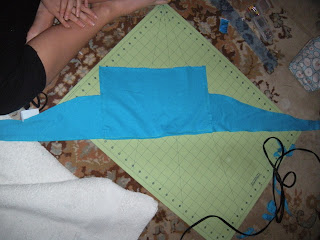While
I was searching for the perfect cover-up to take with me to the Bahamas, I
noticed that I’m either a cheapskate, or things are just overpriced. While staring at one cover-up in particular,
my mother-in-law says “This is just t-shirt fabric, I bet you could make one
really cheap.” Ding, ding, ding!!!
Thanks for making my decision for me. I
grabbed an XL shirt in a color that complimented my skin and set to work. Below is the product. Check out the tutorial to make your own. I just love how it turned out.
A
little more info. I didn’t want to use a
ton of elastic to hold up the dress.
Elastic pinches and creates unattractive rolls even on a thin
person. Easy fix? Use a little elastic for stability and make a
tie-strap in the back just like a
bikini. I did opt for a thicker tie just
because I want the cover-up to be secure and stay in place. Also, using an old t-shirt means you don’t
have to worry about hemming the bottom edge of the dress, it’s already done for
you. I hope you enjoy this project!
Step 1: Gather
your supplies. You will need a HUGE
T-Shirt, scissors, a ruler, ½ inch elastic, 1 inch elastic, and matching or
complimentary thread. I was torn between
two shirts. Obviously I chose blue, so I
decided to use bright green thread.
Step 2: Measure.
I grabbed a dress that fit me just how I wanted the cover-up to and used
it as a guide. Measure a seam allowance
of half an inch on each side of your dress to ensure it fits.
This dress is assembled in a top and bottom. For the bottom piece, add an extra inch to
the top of your measuring (this will make the “skirt”).
For the top, add a half an inch on each side and an
extra inch and a half to the top for your seam allowances. You will only use one piece of the top rectangle
you cut for the bodice.
Step 3: Cut
your shirt. Cut around all of the
measurements you made. You should have 2
skirt pieces (front & back of shirt) and 2 rectangles for the bodice (you
only need one of these pieces).
Cut a straight line under the armpit of the shirt,
using the side you cut the skirt from.
Do this on both sides. These will
make the back straps.
Step 4: Sew
the straps. Right sides facing, stitch
around the bottom hemmed edge and both long edges, leaving the top, raw cut
edge open. Flip right side out and top
stitch all but raw edge.
Step 5: Add
elastic to the skirt. You will need to
add the ½ inch elastic to the top, raw cut edge of one piece of the skirt. Place the elastic ½ inch down from the top,
raw edge of the fabric. Stretch the elastic, to ensure that it will hold up
your dress.
Pin it down and use a
zig-zag stitch to allow for stretch over the elastic. Stitch down the elastic. Fold down the raw edge over the elastic, and
top stitch, creating a nice hem.
Step 6: Sew the
skirt. Place the 2 skirt pieces, right
sides facing, and stitch up each side, leaving both the top and bottom
open. You now have a skirt assembled.
Step 7: Add
elastic to the bodice. Using your 1 inch
elastic, add elastic ½ inch from the top of one long edge. Fold fabric over the elastic and iron down,
then pin. Use a zig-zag stitch to secure
the elastic to the fabric.
Step 8: Attach
back straps. With the elastic side of the
bodice facing you, fold over each short edge and iron down. Add the raw edge of the strap to the raw edge
of the folded over seam. Make sure the
straight edge of the strap matches up with the top of the bodice.
Stitch down the entire length of the short
side, securing the strap and making a hem on the side. Use the same process on the other side.
Step 9:
Assemble the dress. With the
bodice top down and wrong side facing you, lay the front of the skirt over the
bottom of the bodice. Attach only to the
front of the skirt and stitch down.
The
front of the skirt will be longer from side-to-side than the bodice. Fix this by creating small darts while stitching
the pieces together. Flip the dress right side out, and there you have it! A cover-up all your own! Enjoy!


























































